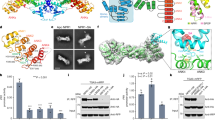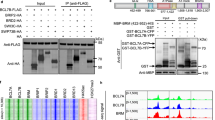Abstract
Plants have evolved efficient defence systems against pathogens that often rely on specific transcriptional responses. Priming is part of the defence syndrome, by establishing a hypersensitive state of defence genes such as after a first encounter with a pathogen. Because activation of defence responses has a fitness cost, priming must be tightly controlled to prevent spurious activation of defence. However, mechanisms that repress defence gene priming are poorly understood. Here, we show that the histone chaperone CAF-1 is required to establish a repressed chromatin state at defence genes. Absence of CAF-1 results in spurious activation of a salicylic acid-dependent pathogen defence response in plants grown under non-sterile conditions. Chromatin at defence response genes in CAF-1 mutants under non-inductive (sterile) conditions is marked by low nucleosome occupancy and high H3K4me3 at transcription start sites, resembling chromatin in primed wild-type plants. We conclude that CAF-1-mediated chromatin assembly prevents the establishment of a primed state that may under standard non-sterile growth conditions result in spurious activation of SA-dependent defence responses and consequential reduction of plant vigour.
This is a preview of subscription content, access via your institution
Access options
Subscribe to this journal
Receive 12 digital issues and online access to articles
$119.00 per year
only $9.92 per issue
Buy this article
- Purchase on Springer Link
- Instant access to full article PDF
Prices may be subject to local taxes which are calculated during checkout





Similar content being viewed by others
References
Vlot, A. C., Dempsey, D. A. & Klessig, D. F. Salicylic Acid, a multifaceted hormone to combat disease. Annu. Rev. Phytopathol. 47, 177–206 (2009).
Fu, Z. Q. & Dong, X. Systemic acquired resistance: turning local infection into global defense. Annu. Rev. Plant Biol. 64, 839–863 (2013).
Conrath, U. et al. Priming: getting ready for battle. Mol. Plant Microbe Interact. 19, 1062–1071 (2006).
Conrath, U. Molecular aspects of defence priming. Trends Plant Sci. 16, 524–531 (2011).
Pieterse, C. M. et al. Induced systemic resistance by beneficial microbes. Annu. Rev. Phytopathol. 52, 347–375 (2014).
Bruce, T. J. A., Matthes, M. C., Napier, J. A. & Pickett, J. A. Stressful “memories” of plants: Evidence and possible mechanisms. Plant Sci. 173, 603–608 (2007).
Burgess, R. J. & Zhang, Z. Histone chaperones in nucleosome assembly and human disease. Nature Struct. Mol. Biol. 20, 14–22 (2013).
JiaoRamirez-Parra, E. & Gutierrez, C. The many faces of Chromatin Assembly Factor 1. Trends Plant Sci. 12, 570–576 (2007).
Kaya, H. et al. FASCIATA genes for Chromatin Assembly Factor-1 in Arabidopsis maintain the cellular organization of apical meristems. Cell 104, 131–142 (2001).
Kaufman, P. D., Kobayashi, R., Kessler, N. & Stillman, B. The p150 and p60 subunits of chromatin assembly factor 1: a molecular link between newly synthesized histones and DNA replication. Cell 81, 1105–1114 (1995).
Hoek, M. & Stillman, B. Chromatin Assembly Factor-1 is essential and couples chromatin assembly to DNA replication in vivo. Proc. Natl Acad. Sci. USA 100, 12183–12188 (2003).
Kaufman, P. D., Kobayashi, R. & Stillman, B. Ultraviolet radiation sensitivity and reduction of telomeric silencing in Saccharomyces cerevisiae cells lacking Chromatin Assembly Factor-1. Genes Dev. 11, 345–357 (1997).
Endo, M. et al. Increased frequency of homologous recombination and T-DNA integration in Arabidopsis CAF-1 mutants. EMBO J. 25, 5579–5590 (2006).
Chen, Z., Tan, J. L., Ingouff, M., Sundaresan, V. & Berger, F. Chromatin Assembly Factor-1 regulates the cell cycle but not cell fate during male gametogenesis in Arabidopsis thaliana. Development 135, 65–73 (2007).
Ramirez-Parra, E. & Gutierrez, C. E2F regulates FASCIATA1, a chromatin assembly gene whose loss switches on the endocycle and activates gene expression by changing the epigenetic status. Plant Physiol. 144, 105–120 (2007).
Schönrock, N., Exner, V., Probst, A., Gruissem, W. & Hennig, L. Functional genomic analysis of CAF-1 mutants in Arabidopsis thaliana. J. Biol. Chem. 281, 9560–9568 (2006).
Kirik, A., Pecinka, A., Wendeler, E. & Reiss, B. The Chromatin Assembly Factor subunit FASCIATA1 is involved in homologous recombination in plants. Plant Cell 18, 2431–2442 (2006).
Mozgova, I., Mokros, P. & Fajkus, J. Dysfunction of Chromatin Assembly Factor-1 induces shortening of telomeres and loss of 45S rDNA in Arabidopsis thaliana. Plant Cell 22, 2768–2780 (2010).
Ono, T. et al. Chromatin Assembly Factor-1 ensures the stable maintenance of silent chromatin states in Arabidopsis. Genes Cells 11, 153–162 (2006).
Exner, V., Taranto, P., Schönrock, N., Gruissem, W. & Hennig, L. Chromatin assembly factor CAF-1 is required for cellular differentiation during plant development. Development 133, 4163–4172 (2006).
Hisanaga, T. et al. The ATM-dependent DNA damage response acts as an upstream trigger for compensation in the fas1 mutation during Arabidopsis leaf development. Plant Physiol. 162, 831–841 (2013).
Leyser, H. M. & Furner, I. J. Characterisation of three shoot apical meristem mutants of Arabidopsis thaliana. Development 116, 397–403 (1992).
Baerenfaller, K. et al. Systems-based analysis of Arabidopsis leaf growth reveals adaptation to water deficit. Mol. Syst. Biol. 8, 606 (2012).
Gohre, V., Jones, A. M., Sklenar, J., Robatzek, S. & Weber, A. P. Molecular crosstalk between PAMP-triggered immunity and photosynthesis. Mol. Plant Microbe Interact. 25, 1083–1092 (2012).
Torres Zabala, M. de et al. Chloroplasts play a central role in plant defence and are targeted by pathogen effectors. Nature Plants 1, 15074 (2015).
Denoux, C. et al. Activation of defense response pathways by OGs and Flg22 elicitors in Arabidopsis seedlings. Mol. Plant 1, 423–445 (2008).
Garcion, C. et al. Characterization and biological function of the ISOCHORISMATE SYNTHASE2 gene of Arabidopsis. Plant Physiol. 147, 1279–1287 (2008).
Wiermer, M., Feys, B. J. & Parker, J. E. Plant immunity: the EDS1 regulatory node. Curr. Opin. Plant Biol. 8, 383–389 (2005).
Uknes, S. et al. Acquired resistance in Arabidopsis. Plant Cell 4, 645–656 (1992).
Lodhi, N. et al. Interactions between upstream and core promoter sequences determine gene expression and nucleosome positioning in tobacco PR-1a promoter. Biochim. Biophys. Acta 1779, 634–644 (2008).
Jaskiewicz, M., Conrath, U. & Peterhansel, C. Chromatin modification acts as a memory for systemic acquired resistance in the plant stress response. EMBO Rep. 12, 50–55 (2011).
Ramirez, V., Lopez, A., Mauch-Mani, B., Gil, M. J. & Vera, P. An extracellular subtilase switch for immune priming in Arabidopsis. PLoS Pathogens 9, e1003445 (2013).
van Hulten, M., Pelser, M., van Loon, L. C., Pieterse, C. M. & Ton, J. Costs and benefits of priming for defense in Arabidopsis. Proc. Natl Acad. Sci. USA 103, 5602–5607 (2006).
Heidel, A. J., Clarke, J. D., Antonovics, J. & Dong, X. Fitness costs of mutations affecting the systemic acquired resistance pathway in Arabidopsis thaliana. Genetics 168, 2197–2206 (2004).
Lawton, K., Weymann, K., Friedrich, L., Vernooij, B., Uknes, S. & Ryals, J. Systemic acquired resistance in Arabidopsis requires salicylic acid but not ethylene. Mol. Plant Microbe Interact. 8, 863–870 (1995).
Fragniere, C., Serrano, M., Abou-Mansour, E., Metraux, J. P. & L'Haridon, F. Salicylic acid and its location in response to biotic and abiotic stress. FEBS Lett. 585, 1847–1852 (2011).
Bowling, S. A. et al. A mutation in Arabidopsis that leads to constitutive expression of systemic acquired resistance. Plant Cell 6, 1845–1857 (1994).
Frye, C. A. & Innes, R. W. An Arabidopsis mutant with enhanced resistance to powdery mildew. Plant Cell 10, 947–956 (1998).
Po-Wen, C., Singh, P. & Zimmerli, L. Priming of the Arabidopsis pattern-triggered immunity response upon infection by necrotrophic Pectobacterium carotovorum bacteria. Mol. Plant Pathol. 14, 58–70 (2013).
Singh, P. et al. Environmental history modulates Arabidopsis pattern-triggered immunity in a HISTONE ACETYLTRANSFERASE1-dependent manner. Plant Cell 26, 2676–2688 (2014).
March-Diaz, R. et al. Histone H2A.Z and homologues of components of the SWR1 complex are required to control immunity in Arabidopsis. Plant J. 53, 475–487 (2008).
Yan, S. et al. Salicylic acid activates DNA damage responses to potentiate plant immunity. Mol. Cell 52, 602–610 (2013).
Choi, S. M. et al. HDA19 is required for the repression of salicylic acid biosynthesis and salicylic acid-mediated defense responses in Arabidopsis. Plant J. 71, 135–146 (2012).
Weng, M. et al. Histone chaperone ASF1 is involved in gene transcription activation in response to heat stress in Arabidopsis thaliana. Plant Cell Environ. 37, 2128–2138 (2014).
Rehrauer, H. et al. AGRONOMICS1: A new resource for Arabidopsis transcriptome profiling. Plant Physiol. 152, 487–499 (2010).
Mackey, D., Belkhadir, Y., Alonso, J. M., Ecker, J. R. & Dangl, J. L. Arabidopsis RIN4 is a target of the type III virulence effector AvrRpt2 and modulates RPS2-mediated resistance. Cell 112, 379–389 (2003).
Ishiga, Y., Ishiga, T., Uppalapati, S. R. & Mysore, K. S. Arabidopsis seedling flood-inoculation technique: a rapid and reliable assay for studying plant-bacterial interactions. Plant Methods 7, 32 (2011).
Shu, H., Gruissem, W. & Hennig, L. Measuring Arabidopsis chromatin accessibility using DNase I-polymerase chain reaction and DNase I-chip assays. Plant Physiol. 162, 1794–1801 (2013).
Acknowledgements
This work was supported by EMBO fellowship ALTF_1492-2011 to I.M., by grants to L.H. from the Swiss National Science Foundation, the Swedish Research Councils VR and FORMAS, by the Sixth Framework Program of the European Commission through the AGRON-OMICS Integrated Project (grant no. LSHG-CT-2006-037704 to W.G.), by the Knut-and-Alice Wallenberg foundation to L.H. and D.H., and by grant 310030B_141176 from the Swiss National Science Foundation to J.-P.M. We thank the reviewers for valuable comments that helped to improve the manuscript.
Author information
Authors and Affiliations
Contributions
I.M., T.W., Q.L., E.A.-M. and F.H. performed the experiments; I.M., T.W. and L.H. analysed data; I.M., T.W., D.H., J.-P.M., W.G. and L.H. planned the experiments; and I.M., D.H., W.G. and L.H. wrote the manuscript.
Corresponding author
Ethics declarations
Competing interests
The authors declare no competing financial interests.
Supplementary information
Rights and permissions
About this article
Cite this article
Mozgová, I., Wildhaber, T., Liu, Q. et al. Chromatin assembly factor CAF-1 represses priming of plant defence response genes. Nature Plants 1, 15127 (2015). https://doi.org/10.1038/nplants.2015.127
Received:
Accepted:
Published:
DOI: https://doi.org/10.1038/nplants.2015.127
This article is cited by
-
Identification of epigenetically regulated genes involved in plant-virus interaction and their role in virus-triggered induced resistance
BMC Plant Biology (2024)
-
Epigenetic regulation of plant immunity: from chromatin codes to plant disease resistance
aBIOTECH (2023)
-
Histone chaperone ASF1 mediates H3.3-H4 deposition in Arabidopsis
Nature Communications (2022)
-
Heteromeric HSFA2/HSFA3 complexes drive transcriptional memory after heat stress in Arabidopsis
Nature Communications (2021)
-
Role of WRKY transcription factors in plant defense against lepidopteran insect herbivores: an overview
Journal of Plant Biochemistry and Biotechnology (2021)



